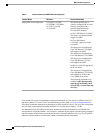
• MPLS LDP GR is supported in strict helper mode.
• Tag Distribution Protocol (TDP) sessions are not supported. Only LDP sessions are supported.
• MPLS LDP GR cannot be configured on label-controlled ATM (LC-ATM) interfaces.
• MPLS LDP SSO/NSF is supported in IOS Release 12.2(25)S. It is not supported in this release.
Information About MPLS LDP Graceful Restart
• How MPLS LDP Graceful Restart Works, page 66
• How a Route Processor Advertises That It Supports MPLS LDP Graceful Restart, page 67
• What Happens If a Route Processor Does Not Have LDP Graceful Restart, page 67
How MPLS LDP Graceful Restart Works
MPLS LDP GR works in strict helper mode, which means it helps a neighboring route processor that has
MPLS LDP SSO/NSF to recover from disruption in service without losing its MPLS forwarding state. The
disruption in service could be the result of a TCP or UDP event or the stateful switchover of a route
processor. When the neighboring router establishes a new session, the LDP bindings and MPLS forwarding
states are recovered.
In the topology shown in the figure below, the following elements have been configured:
• LDP sessions are established between Router 1 and Router 2, as well as between Router 2 and Router
3.
• Router 2 has been configured with MPLS LDP SSO/NSF. Routers 1 and 3 have been configured with
MPLS LDP GR.
• A label switched path (LSP) has been established between Router 1 and Router 3.
Figure 4
Example of a Network Using LDP Graceful Restart
The following process shows how Routers 1 and 3, which have been configured with LDP GR help Router
2, which has been configured with LDP SSO/NSF recover from a disruption in service:
1
Router 1 notices an interruption in service with Router 2. (Router 3 also performs the same actions in
this process.)
2
Router 1 marks all the label bindings from Router 2 as stale, but it continues to use the bindings for
MPLS forwarding.
Router 1 reestablishes an LDP session with Router 2, but keeps its stale label bindings. If you issue a show
mpls ldp neighbor command with the graceful-restart keyword, the command output displays the
recovering LDP sessions.
1
Both routers readvertise their label binding information. If Router 1 relearns a label from Router 2 after
the session has been established, the stale flags are removed. The show mpls forwarding-
tablecommand displays the information in the MPLS forwarding table, including the local label,
outgoing label or VC, prefix, label-switched bytes, outgoing interface, and next hop.
You can set various graceful restart timers. See the following commands for more information:
How MPLS LDP Graceful Restart Works
Information About MPLS LDP Graceful Restart
MPLS LDP Configuration Guide, Cisco IOS Release 12.4
66


















